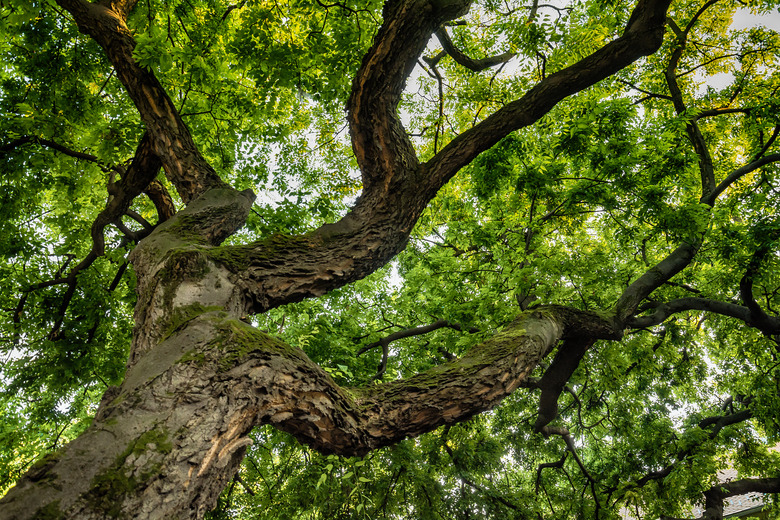How To Tell If An Oak Tree Is Dead
Although oak trees existed long before you were born and will continue to exist after you're gone, it's vital to know how to tell if an oak tree (Quercus spp.) is dead or dying. Many homeowners may not want to get rid of dead or dying trees, but hanging on to an oak tree in its weaker moments can cause more harm to the tree and you.
Tip
Signs of a dead or dying oak tree are discolored or missing bark, dead or missing leaves, and damaged or decaying roots.
Discolored or Missing Bark
Discolored or Missing Bark
Major signs of a dead or dying oak tree are decaying and missing bark. Vertical cracks, no bark or yellow or brown colors under the bark are a no-go when it comes to oak trees. It's natural for old bark to fall off, but that fallen bark layer is always replaced with a new bark layer. If bark does not grow back and your tree has smooth wood showing, your oak tree is dying.
Another sign that your oak tree is dead or dying is yellow or green colors showing under the oak tree's bark. If you suspect your tree is dead or dying, scrape back the bark in multiple areas. Healthy oak trees will showcase green coloration underneath the bark, but dead or dying trees will showcase a yellow or brownish color underneath the bark. When you notice signs of trunk damage, you need to call an experienced arborist to see if your tree is already dead or dying.
Dead or Missing Leaves
Dead or Missing Leaves
If your oak tree is exhibiting branches with dead leaves, this is another indicator that your oak tree is either dead or dying. Healthy oak trees are supposed to lose their leaves, and dead leaves naturally drop to the ground, but if dead leaves are clinging to branches, then that's a sign that your branches are dead. Also, leaves are supposed to come back in the spring naturally, but if more than one-third of your tree doesn't have leaves coming in, your tree most likely needs to be removed.
Unfortunately, trees with dead leaves or dead branches need to be removed. Hiring a certified arborist to come and inspect your tree is vital because you don't want fallen limbs to cause severe damage.
Another way to spot a dead or dying oak tree is by examining the new growth patterns. If you notice that new growth is only happening on the lower branches and the top branches look dead or are breaking off, this is, unfortunately, a sign of a dying tree.
Damaged or Decaying Roots
Damaged or Decaying Roots
If your tree's roots are damaged or decaying, you need to have your oak tree removed immediately. Oak trees can get oak root rot due to two diseases: fungi and water mold. Either or a combination of these two diseases contributes to oak root rot. You need to immediately have your oak tree removed because an oak tree's roots are the tree's foundation.
When the roots become decayed or damaged, the tree has lost all structural support, and it will eventually fall over on its own. Another sign of root damage is if you see small shoots, called epicormic shoots, sprouting at the base of your oak tree's trunk. If you notice these shoots growing at the base of the oak tree's trunk, this is a sign that your tree is under stress.
As soon as you see epicormic shoots, call a certified arborist to assess the health of your tree. The arborist will determine if your oak tree is dying and if it needs to be removed.
